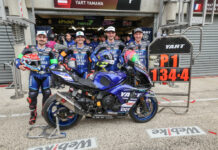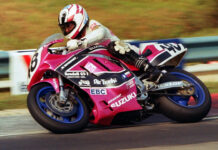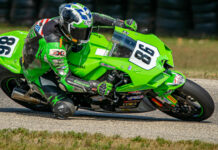By Joe Facer
I don’t think that there is a way to optimize the decision process behind throwing the red flag to eliminate controversy. The red flag is about safety and the way that you determine that you are not being throwing the red flag enough is that preventable injuries or deaths occur. So the proper course is to err on the side of safety. What there is room for is a discussion about making a red flag and the subsequent restart fair. Should we require that racers park the bikes on the grid and that the riders and mechanics walk away until the time comes to fire the bikes up for the restart? That seems fair. Nobody gets a free pit stop and racers with perfect set-ups aren’t penalized and those with mechanical problems aren’t bailed out.
Everybody starts off with what they had when they stopped. But I have a major problem with this. Motorcycle racing is dangerous and it is hard to deny anybody an opportunity to make it safer. Fresh tires for the restart, tire warmers on the bikes while they are waiting, fresh brake pads and/or rotors, suspension adjustments, and minor mechanical repairs as required, are all things that can make racing safer. They can result in a racer doing better than he otherwise would have without the red flag situation, but that’s racing. When you are on two wheels, there’s not much that isn’t safety related.
Should you use the scoring transponders to keep an aggregate time for both parts of the race, and make the finishing positions correspond to the aggregate times? Here we have something that seems workable and fair.
A racer creates a 10-second lead over the racer behind him, based on the time they crossed the finish line on the lap previous to the lap during which the red flag appeared. He keeps that advantage to the end of the race. He has to be beaten by the second place rider by more than 10 seconds to lose the first place. World Championship Grand Prix races are scored on this basis and you can’t ask for a much bigger precedent than that.
But I’d rather not see it. Here’s why: Everybody talks about the success of NASCAR, and what they do, and what we motorcycle racers ought to do, and what if only we could do. NASCAR is very effective in maximizing the entertainment value of their racing. They race formula cars, not stock cars, and the cars are built to a very tight spec. They are further held to a performance formula. If one brand consistently shows too much speed and is too successful, they’ll find themselves with a little more or less spoiler or restrictor or rake until the racing is head-to-head again.
Everything NASCAR does is done with any eye toward eliminating any technical advantage, and advancing the state of racing technology is of no concern, or an incidental afterthought at the very best. It is all about close racing The full-course yellow flag, pace car, and restart are very much a part of this. In the 1950s and 1960s, it was suspected that when the racing got too boring or processional, a full-course yellow flag, ostensibly for debris on the track, would go out to close up the pack behind the pace car and stir things up with a restart. When the drivers would come in and ask who caused the yellow, the crew would tell them that it was that driver with the French name that caused it, Monsieur Debris.
With real-time TV broadcasts and a multitude of cameras and high-quality mega-zoom lenses, it is hard to imagine very much of this happening today, without it being pretty obvious. Still, to a certain extent, the full-course yellow and restart closes the field and maximizes wheel-to-wheel racing in close quarters, keeping things more exciting than they otherwise would be.
To be continued…






